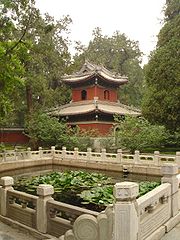
Beijing Botanical Garden
Encyclopedia

Botanical garden
A botanical garden The terms botanic and botanical, and garden or gardens are used more-or-less interchangeably, although the word botanic is generally reserved for the earlier, more traditional gardens. is a well-tended area displaying a wide range of plants labelled with their botanical names...
situated in the northwestern outskirts of Beijing
Beijing
Beijing , also known as Peking , is the capital of the People's Republic of China and one of the most populous cities in the world, with a population of 19,612,368 as of 2010. The city is the country's political, cultural, and educational center, and home to the headquarters for most of China's...
, China between Xiangshan
Fragrant Hills
Fragrant Hills Park is a public park at the foot of the Western Mountains in the Haidian District, in the northwestern part of Beijing, China. It covers 1.6 km² and consists of a natural pine-cypress forest, hills with maple trees, smoke trees and persimmon trees, as well as landscaped areas with...
(Fragrant Hills) Park and Jade Spring Mountain (:zh:玉泉山) in the Western Hills
Western Hills
The Western Hills refers to the hills and mountains in the western part of Beijing.- Geography :Being an extension of the Taihang mountain range from Hebei Province, the Western Hills cover about 17% of Beijing municipality including most of Mentougou and Fangshan Districts as well as parts of...
.
History
The Beijing Botanical Garden was established in 1955. It covers a large area of 564,000 square metres. The gardens include a dozen exhibition districts and halls, such as the tree garden, a perennial bulb garden, a rose garden, a peony garden, a traditional Chinese medical herb garden, a wild fruit resources district, an environment protection plant district, a water and vine plant district, an endangered plant district, and exhibition greenhouses for tropical and subtropical plants. There are several Buddhist temples located within the botanic gardens.Collection
The gardens cultivate 6,000 species of plant, including 2,000 kinds of trees and bushes, 1,620 varieties of tropical and subtropical plants, 500 species of flowers and 1,900 kinds of fruit trees, water plants, traditional Chinese.The hothouse exhibition is the highlight of the garden
Garden
A garden is a planned space, usually outdoors, set aside for the display, cultivation, and enjoyment of plants and other forms of nature. The garden can incorporate both natural and man-made materials. The most common form today is known as a residential garden, but the term garden has...
s.
- The first room is filled with evergreens and members of the palm family.
- The second room is given over to tropical aquatic plants, including water lilies and flowering taros.
- The third room displays commercial plants and their breeding and propagation. Here there are specimens of the triple-leaved rubber plant, cocoa and coffee trees and the sugar producing sweet-leaved chrysanthemum which has been introduced into China from abroad.
There are rooms for demonstrating medicinal plants, aromatic plants and succulents. The exhibition of ornamental plants is spectacular with its countless varieties if flowers and grasses. There are over 300 different varieties of orchid, among them a rootless one that relies on fine hairs to absorb water vapor and nutrients from the air.
Besides the hothouse, there is also a national plant specimen hall with a floor space of 11,000 square meters. Specimen houses, plant classification laboratories, research rooms and a lecture hall are arranged around a courtyard linked by arches and trellises.
The Peony
Peony
Peony or paeony is a name for plants in the genus Paeonia, the only genus in the flowering plant family Paeoniaceae. They are native to Asia, southern Europe and western North America...
Garden was open to the public in 1981. It covers an area of 100,000 square metres and is divided into three sections. The Peony Grove is the most important, covering an area of 35,000 square metres.
The plant collection includes many rare species. There is, for example, the metasequoia first discovered in the region of Hubei and Sichuan by a Chinese scientist in the 1940s. Since it was originally believed that it had become extinct during the Tertiary Period (65 million years ago), the discovery of living specimens in China came as a tremendous surprise to botanists.
Other plants in the gardens include Nepenthes
Nepenthes
The Nepenthes , popularly known as tropical pitcher plants or monkey cups, are a genus of carnivorous plants in the monotypic family Nepenthaceae. The genus comprises roughly 130 species, numerous natural and many cultivated hybrids...
pitcher plant
Pitcher plant
Pitcher plants are carnivorous plants whose prey-trapping mechanism features a deep cavity filled with liquid known as a pitfall trap. It has been widely assumed that the various sorts of pitfall trap evolved from rolled leaves, with selection pressure favouring more deeply cupped leaves over...
s, which are carnivorous plant
Carnivorous plant
Carnivorous plants are plants that derive some or most of their nutrients from trapping and consuming animals or protozoans, typically insects and other arthropods. Carnivorous plants appear adapted to grow in places where the soil is thin or poor in nutrients, especially nitrogen, such as acidic...
s; the golden butterfly orchid with its lustrous yellow flowers; the American redwood; the Japanese blossoming cherry, and the famous "botree", the tree under which Buddha sat when he gained enlightenment.

